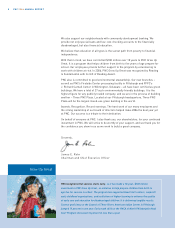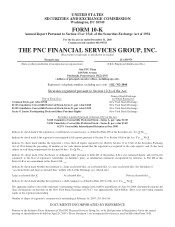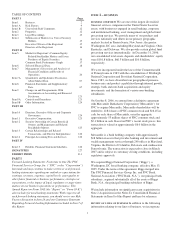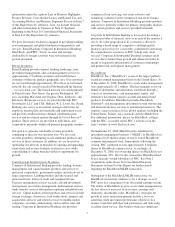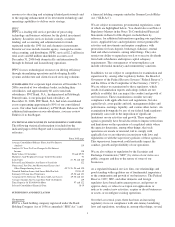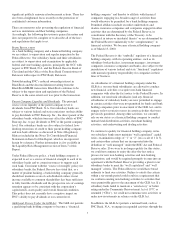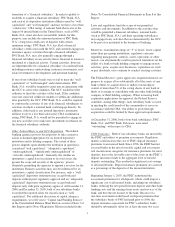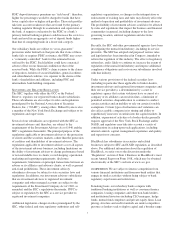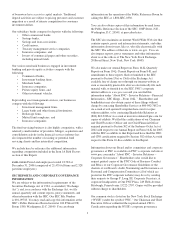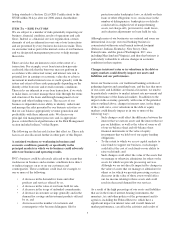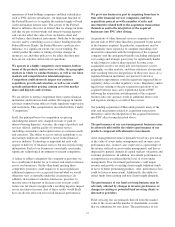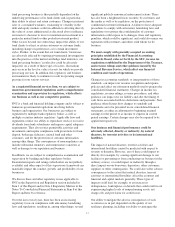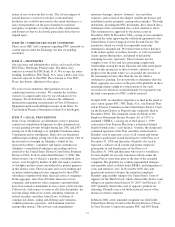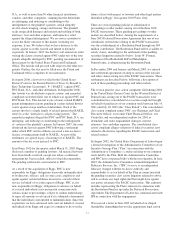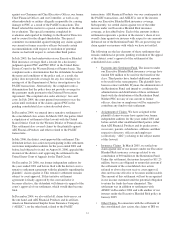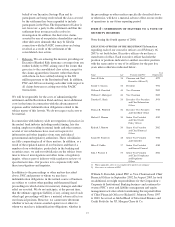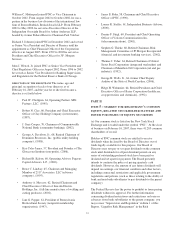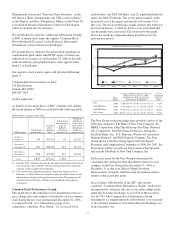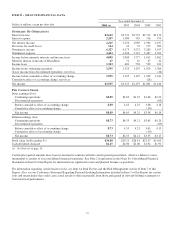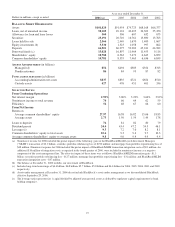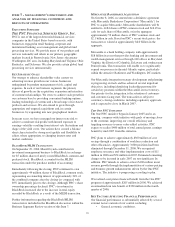PNC Bank 2006 Annual Report Download - page 20
Download and view the complete annual report
Please find page 20 of the 2006 PNC Bank annual report below. You can navigate through the pages in the report by either clicking on the pages listed below, or by using the keyword search tool below to find specific information within the annual report.operations of bank holding companies and their subsidiaries,
such as PNC and our subsidiaries. An important function of
the Federal Reserve is to regulate the national supply of bank
credit and market interest rates. The actions of the Federal
Reserve influence the rates of interest that we charge on loans
and that we pay on borrowings and interest-bearing deposits
and can also affect the value of our on-balance sheet and
off-balance sheet financial instruments. Both due to the impact
on rates and by controlling access to direct funding from the
Federal Reserve Banks, the Federal Reserve’s policies also
influence, to a significant extent, our cost of funding. We
cannot predict the nature or timing of future changes in
monetary, tax and other policies or the effect that they may
have on our activities and results of operations.
We operate in a highly competitive environment, both in
terms of the products and services we offer, the geographic
markets in which we conduct business, as well as our labor
markets and competition for talented employees.
Competition could adversely impact our customer
acquisition, growth and retention, as well as our credit
spreads and product pricing, causing us to lose market
share and deposits and revenues.
We are subject to intense competition from various financial
institutions and from non-bank entities that engage in similar
activities without being subject to bank regulatory supervision
and restrictions. This competition is described in Item 1 under
“Competition.”
In all, the principal bases for competition are pricing
(including the interest rates charged on loans or paid on
interest-bearing deposits), structure, the range of products and
services offered, and the quality of customer service
(including convenience and responsiveness to customer needs
and concerns). The ability to access and use technology is an
increasingly important competitive factor in the financial
services industry. Technology is important not only with
respect to delivery of financial services but also in processing
information. Each of our businesses consistently must make
significant technological investments to remain competitive.
A failure to address adequately the competitive pressures we
face could make it harder for us to attract and retain customers
across our businesses. On the other hand, meeting these
competitive pressures could require us to incur significant
additional expenses or to accept risk beyond what we would
otherwise view as desirable under the circumstances. In
addition, in our interest sensitive businesses, pressures to
increase rates on deposits or decrease rates on loans could
reduce our net interest margin with a resulting negative impact
on our net interest income. Any of these results would likely
have an adverse effect on our overall financial performance.
We grow our business in part by acquiring from time to
time other financial services companies, and these
acquisitions present us with a number of risks and
uncertainties related both to the acquisition transactions
themselves and to the integration of the acquired
businesses into PNC after closing.
Acquisitions of other financial services companies also
present risks to PNC other than those presented by the nature
of the business acquired. In particular, acquisitions may be
substantially more expensive to complete (including costs
incurred in connection with the integration of the acquired
company) and the anticipated benefits (including anticipated
cost savings and strategic gains) may be significantly harder
or take longer to achieve than expected. In some cases,
acquisitions involve our entry into new businesses or new
geographic or other markets, and these situations also present
risks resulting from our inexperience in these new areas. As a
regulated financial institution, our pursuit of attractive
acquisition opportunities could be negatively impacted due to
regulatory delays or other regulatory issues. Regulatory and/or
legal issues relating to the pre-acquisition operations of an
acquired business may cause reputational harm to PNC
following the acquisition and integration of the acquired
business into ours and may result in additional future costs
and expenses arising as a result of those issues.
Our pending acquisition of Mercantile presents many of the
risks and uncertainties related to acquisition transactions
themselves and to the integration of the acquired businesses
into PNC after closing described above.
The performance of our asset management businesses may
be adversely affected by the relative performance of our
products compared with alternative investments.
Asset management revenue is primarily based on a percentage
of the value of assets under management and, in some cases,
performance fees, in most cases expressed as a percentage of
the returns realized on assets under management, and thus is
impacted by general changes in capital markets valuations and
customer preferences. In addition, investment performance is
an important factor influencing the level of assets under
management. Poor investment performance could impair
revenue and growth as existing clients might withdraw funds
in favor of better performing products. Also, performance fees
could be lower or nonexistent. Additionally, the ability to
attract funds from existing and new clients might diminish.
The performance of our fund servicing business may be
adversely affected by changes in investor preferences, or
changes in existing or potential fund servicing clients or
alternative providers.
Fund servicing fees are primarily derived from the market
value of the assets and the number of shareholder accounts
that we administer for our clients. The performance of our
10


